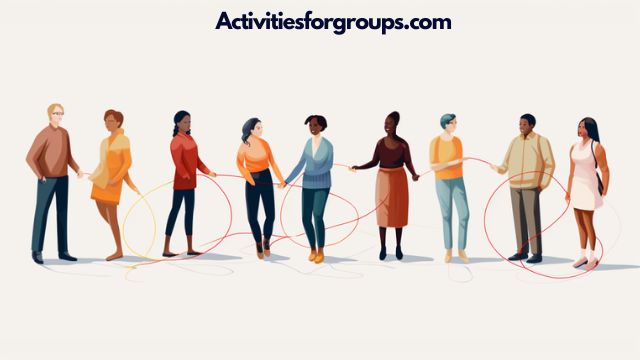Do you want to foster healthy competition among your friends or coworkers? Group activities are a great way to do just that.

Not only are they fun, but they can also help build relationships and teamwork skills. Plus, by encouraging friendly competition, you can boost morale and create an atmosphere of camaraderie.
In this article, we’ll look at the benefits of group activities and provide strategies for making them competitive yet positive experiences. You’ll also find some examples of group activities that will encourage everyone to get involved.
Group Activities Ideas To Encourage Healthy Competition
| Activity Idea | How It Encourages Healthy Competition |
|---|---|
| Team Sports (e.g., Soccer, Basketball, Volleyball) | Teams compete against each other to win the game, fostering a sense of camaraderie and teamwork while also pushing each individual to perform at their best. |
| Debate Club | Members research and present arguments on various topics, competing to persuade judges or an audience. This encourages critical thinking and effective communication. |
| Trivia Nights | Groups compete by answering questions on a range of subjects. This encourages participants to broaden their knowledge and think quickly. |
| Fitness Challenges (e.g., Step Count, Marathon Training) | Individuals or teams set fitness goals and track progress, promoting personal growth and mutual encouragement. |
| Cooking Contests | Competitors prepare dishes to be judged on taste, presentation, and creativity, encouraging culinary skills and time management. |
| Hackathons | Teams of programmers and designers compete to create software projects within a limited time, stimulating innovation and problem-solving. |
| Book Clubs with Monthly Reading Goals | Members aim to read and discuss a set number of books, fostering a love for reading and an opportunity for intellectual debate. |
| Art Competitions | Artists create works based on a theme and compete for recognition, motivating creativity and technique refinement. |
| Science Fairs | Participants present research and experiments, competing for prizes or recognition, which promotes scientific inquiry and methodical thinking. |
| Scavenger Hunts | Teams race to find items or complete tasks based on clues, encouraging strategic thinking and collaboration. |
| Sales Competitions | Sales teams compete to hit targets or achieve the highest sales, incentivizing performance and customer engagement strategies. |
| Music Battles (e.g., Battle of the Bands) | Musical groups perform in front of an audience that votes on the best act, inspiring practice and artistic expression. |
| Board Game Tournaments | Players compete in strategy or knowledge-based games, promoting critical thinking and decision-making under pressure. |
| Community Service Competitions | Groups compete to contribute the most volunteer hours or raise the most resources for a cause, encouraging social responsibility and teamwork. |
| Language Learning Challenges | Learners compete to master a new language or reach specific proficiency goals, fostering dedication and cultural awareness. |
Each of these activities can be structured to prioritize fair play and mutual respect, ensuring that the competition remains healthy and contributes positively to personal growth and community building.
Benefits of Group Activities
Group activities not only foster collaboration, but they can also bring out healthy competition that helps everyone reach their potential! Participating in group activities is a great way for people to work together and learn from one another.
Collaborative learning allows individuals to build on each other’s ideas while working towards common goals. Through this form of learning, participants gain knowledge that they wouldn’t have otherwise acquired.
Additionally, the social dynamics of group activities encourage healthy competition between members. This competition encourages each individual to do their best and strive for success.
Group activities also help with problem-solving skills as well as creativity. By working together with others, individuals are able to come up with creative solutions and brainstorm ideas that may lead to success.
Furthermore, it teaches people respect for one another’s differences and diversity helps create a positive environment where everyone can thrive.
Lastly, these healthy competitions help build confidence in those who participate which can lead to greater performance in the future.
It is clear that group activities can be beneficial when encouraging healthy competition between its members.
Not only does it provide a collaborative atmosphere where participants can learn from one another but also creates an environment where individuals compete in a respectful manner which ultimately helps each person reach their full potential!
Strategies to Encourage Healthy Competition
You can foster friendly rivalry by creating engaging challenges for your team. To encourge healthy competition, set clear goals that are achievable and encourage collaboration between members. Celebrate small successes with rewards, such as a team lunch or an afternoon off.
| Team Building | Social Media |
|---|---|
| Create regular team building activities to promote camaraderie and teamwork among group members. | Use social media platforms to share the team’s progress on their challenges and celebrate their accomplishments publicly. |
| Make sure each challenge has an achievable goal that all participants can work towards together. | Encourage friendly competitions through social media such as “likes” on posts or photo contests to keep everyone engaged. |
| Find ways to recognize individual contributions to the overall success of the challenge. | Provide incentives or rewards for achieving certain milestones during the challenge, like a virtual high-five from the group leader! |
By embracing healthy competition in your group activities, you can motivate each other to reach bigger goals while also fostering a sense of community among your teammates. It’s important to remember that it isn’t about winning or losing but rather coming together and encouraging one another along the way!
Examples of Group Activities

Gathering for group activities can bring team members together in an enjoyable and creative way. Group activities are a great way to encourage healthy competition, as they foster collaboration and promote the identification of individual strengths.
Some examples of group activities that can help encourage healthy competition include:
- A scavenger hunt – Teams will have to work together to find items or complete tasks before the other teams, promoting cooperation and collaboration.
- An escape room challenge – This activity requires teams to work together effectively, utilizing each person’s skillset in order to solve puzzles and advance through the game.
- A friendly sports match – Playing a sport with friends and colleagues is an excellent way to engage in healthy competition while also having fun!
Group activities provide people with an opportunity to learn more about themselves and their teammates while enjoying some friendly competition. They allow everyone involved to build relationships, create memories, and become part of something bigger than themselves.
Ultimately, these types of activities are beneficial for both personal growth and team building!
Conclusion
You’ve seen the benefits of group activities and strategies to encourage healthy competition. Now it’s time to put those ideas into action!
Through team-building exercises, outdoor activities, or even a friendly game night at home, you can get your group to work together while fostering healthy competition.
It’s a great way for everyone involved to learn more about each other and have fun in the process. So go ahead and give it a try!




Leave a Reply